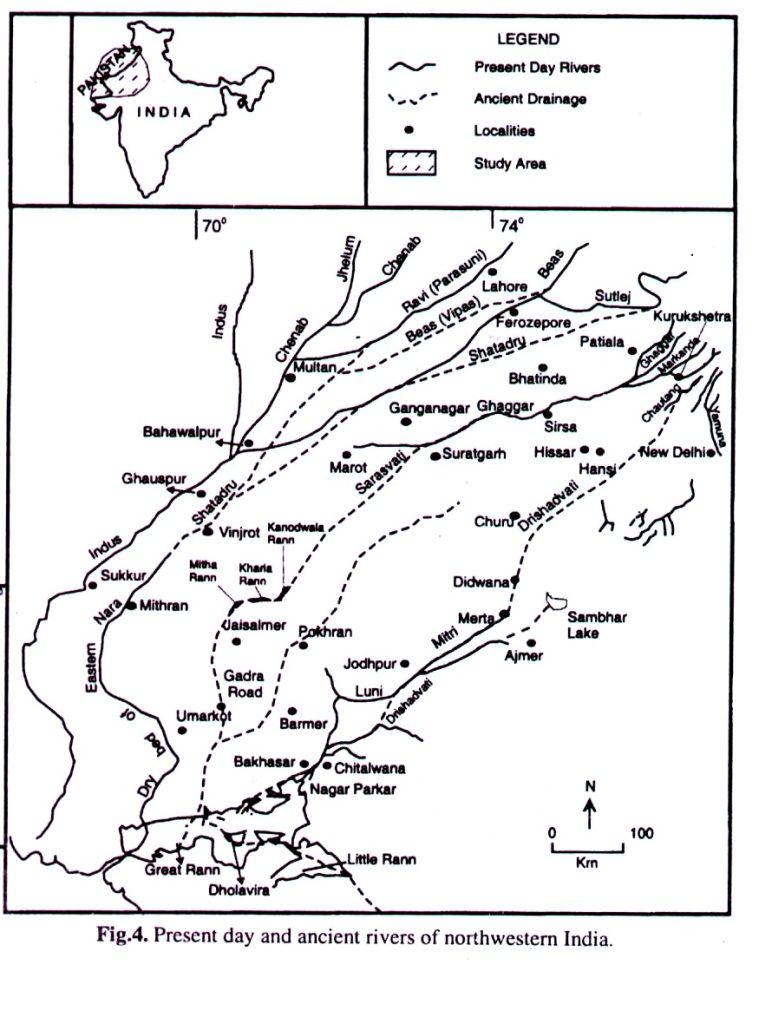The land of the 5 rivers—Punjab, which is called SAPTSINDHUS by the RIGVEDA, and these five rivers are believed to have included the INDUS and its five tributaries- Jhelum, Chenab, Ravi, Beas, and Sutlej and Saraswati rivers. In epics and puranas, Punjab has been referred to as ‘Panchananda’. Greeks called Punjab Pentapotamian.
The name Punjab derives its name from two Persian words- Panj(five) and Ab(water)-meaning Land of five rivers.
After the partition of India in 1947, only the Beas and Sutlej primarily flow through Indian Punjab, while the Jhelum, Chenab, and Ravi lie mostly in Pakistan.
Two types of river
- Perennial (always with water)-Jhelum, Chenab, Ravi, Beas, and Sutlej
- Seasonal or Ephemeral—Ghaggar River
QUICK NOTE
| River | Origin | Cool Fact |
|---|---|---|
| Jhelum | Kashmir | Battle of Hydaspes |
| Chenab | Himachal (Chandra & Bhaga) | River of lovers |
| Ravi | Himachal | Ancient Lahore |
| Beas | Rohtang, Himachal | Alexander turned back here |
| Sutlej | Tibet | Powers Bhakra-Nangal Dam |

Punjab, the land of five river
1. Jhelum River
The Jhelum originates from the Verinag Spring in the southeastern part of the Kashmir Valley and flows through Srinagar and Wular Lake before entering Pakistan via the Line of Control. It eventually merges with the Chenab.
- Length: ~725 km
- Countries: India, Pakistan
- Project: Mangla Dam in Pakistan, a critical hydroelectric and irrigation project.
The Jhelum is one of the “western rivers” allocated to Pakistan under the Indus Waters Treaty (IWT) of 1960. However, India retains limited rights for non-consumptive use like run-of-the-river hydropower projects, which has led to disputes, especially over projects like the Kishanganga Dam.
The Battle of Hydaspes between Alexander the Great and King Porus (326 BCE) occurred along this river, symbolizing a critical moment in Indo-Hellenistic contact.
2. Chenab River
The Chenab is formed in the Lahaul-Spiti region of Himachal Pradesh from the confluence of the Chandra and Bhaga rivers. It flows through Jammu and Kashmir before entering Pakistan’s Punjab province.
- Length: ~960 km
- Flow: Perennial, snow-fed
- Projects: Baglihar Dam, Ratle Hydroelectric Project
Another “western river” under IWT, the Chenab, has been the center of multiple Indo-Pak water disputes, particularly regarding dam height, storage capacity, and flow diversion.
3. Ravi River
The Ravi originates from the Bara Bhangal region in Himachal Pradesh and flows through the Chamba Valley before crossing into Pakistan. Historically known as Iravati, the Ravi once supported key ancient settlements.
- Length: ~720 km
- Dams: Ranjit Sagar Dam (Thein Dam)
- Key Uses: Irrigation, hydroelectricity
Historical & Cultural Note:
The city of Lahore, once a major Mughal and Sikh center, developed along the Ravi’s banks. Today, the river suffers from high pollution levels, especially in its urban stretches.
The Ravi is one of the “eastern rivers” allocated to India under IWT, meaning India has full rights over its waters. It is also linked with Beas via canal systems for inter-basin water transfer.
The Ravi is one of the “eastern rivers” allocated to India under IWT, meaning India has full rights over its waters. It is also linked with Beas via canal systems for inter-basin water transfer.
4. Beas River
The Beas River rises at Beas Kund near Rohtang Pass in Himachal Pradesh. Entirely within Indian territory, it merges with the Sutlej near Harike in Punjab.
- Length: ~470 km
- Major Infrastructure: Pandoh Dam, Luni Hydel Project
- Environmental Significance: Flows through Kullu Valley and is vital for Himalayan ecology.
Historical Moment:
It marked the eastern boundary of Alexander the Great’s march into India. His troops refused to cross the Beas, ending his campaign and signaling the limits of ancient western expansion.
Biodiversity:
Near its confluence with Sutlej lies the Harike Wetland, a Ramsar site rich in bird life and aquatic biodiversity. Also a tourist place.
Pong dam has been constructed across the Beas river, near Talwara.
5. Sutlej River
The Sutlej, or Shatadru in ancient texts, is the longest of the five rivers and the only one originating outside India—from Lake Rakshastal, near Mount Kailash in Tibet. It flows west through Himachal Pradesh and Punjab into Pakistan.
- Length: ~1,550 km
- Project: Bhakra-Nangal Dam, one of India’s largest multipurpose river valley projects
- Irrigation: Forms the backbone of the Indira Gandhi Canal, which even supports agriculture in parts of Rajasthan.
As the main eastern river under the IWT, India can fully harness the Sutlej’s waters. It supports major hydropower, flood control, and extensive canal-based irrigation, especially vital for Punjab and Haryana.
catchment area viewpoint (INDIA)
- Satluj
- BEAS
- RAVI
SEASONAL OR EPHEMERAL RIVER
The Ghaggar River is a seasonal river in northwestern India, primarily flowing through the states of Himachal Pradesh, Haryana, Punjab, and Rajasthan. It disappears into the Thar Desert, and does not reach the sea. It is best known for its historical and archaeological significance, often linked with the ancient Saraswati River mentioned in the Vedas.
The Ghaggar is a monsoon-fed river that remains dry for most of the year, except during the rainy season. Its seasonal flow has prevented it from becoming a major navigable or perennial river in modern times.
STUDY POINTS (GENERAL KNOWLEDGE)
More than 400 Harappan sites (like Kalibangan, Banawali, Rakhigarhi, and Bhirrana) have been found along its dry bed, suggesting this river was a cradle of the Indus Valley Civilization.
Interlink with Rigvedic history: Saraswati-Ghaggar debate
Geostrategic context: Lies near the Indo-Pak border; often cited in ancient river mapping
Environmental concern: Disappearing rivers and desertification
Archaeology: Harappan sites along a non-perennial river
Current use: Mainly for local irrigation and floodwater drainage in Haryana and Rajasthan
Indus Waters Treaty – A Framework for Sharing Water
Established in 1960 with the help of the World Bank, the Indus Waters Treaty is a significant agreement between India and Pakistan. It separates the six rivers of the Indus system into:
Eastern Rivers (Sutlej, Beas, Ravi): designated for India
Western Rivers (Jhelum, Chenab, Indus): designated for Pakistan, with India permitted limited usage.
Even though it has faced challenges during wars and diplomatic conflicts, the IWT has mostly remained intact, serving as an example of transboundary water management.
The five rivers are the lifelines of Punjab’s agriculture, which earned the state its title as “India’s Granary.” These rivers irrigate millions of hectares of wheat, rice, sugarcane, and cotton fields

